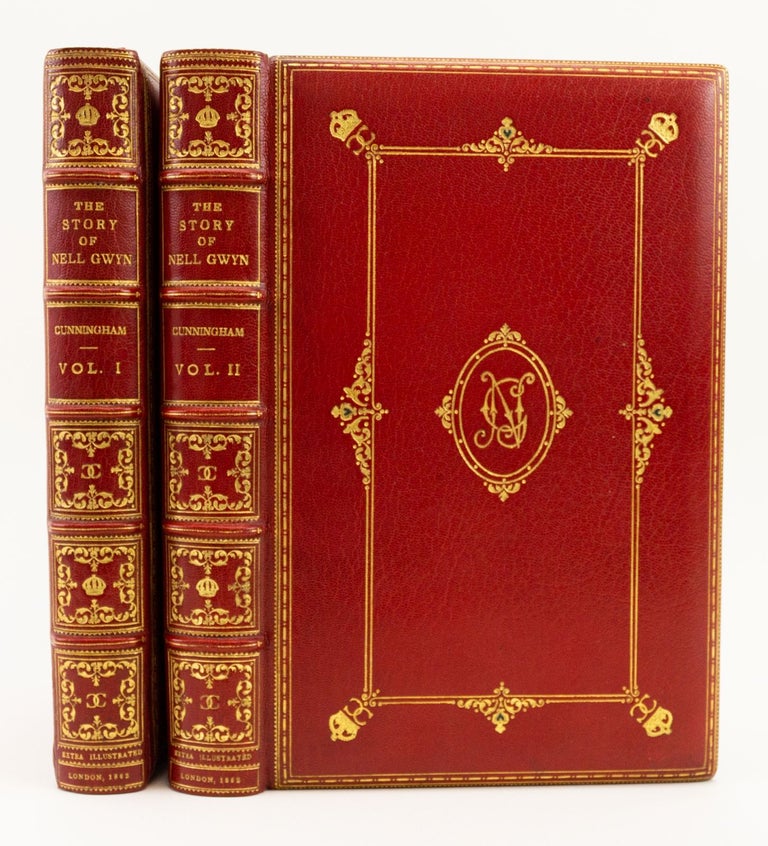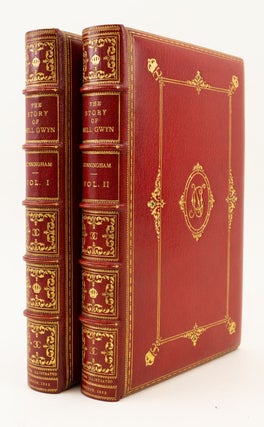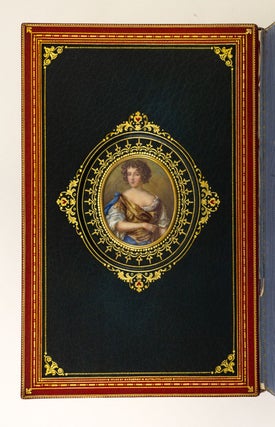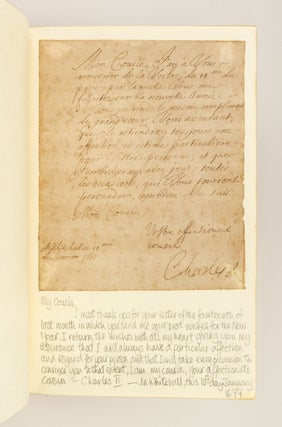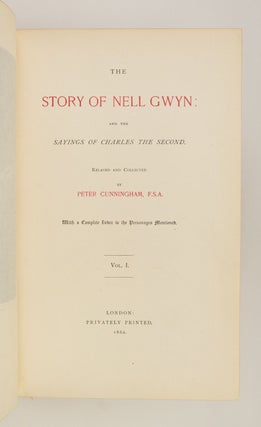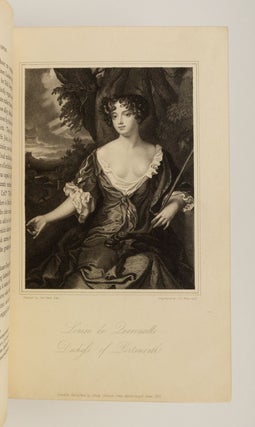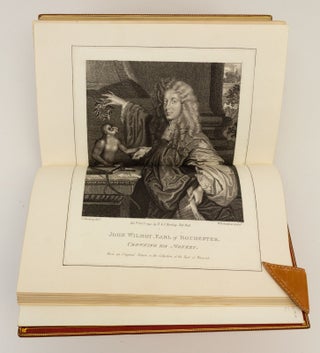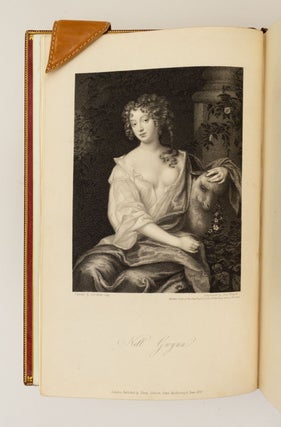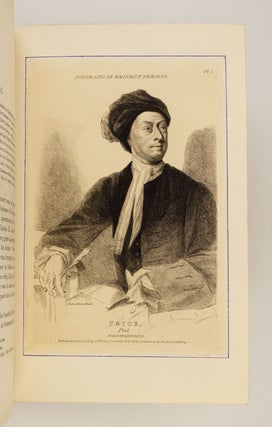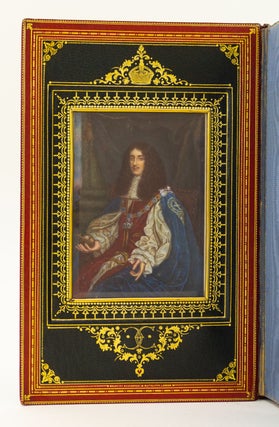THE STORY OF NELL GWYN AND THE SAYINGS OF CHARLES II.
(London: Privately Printed, 1862). 270 x 173 mm. (10 3/4 x 6 3/4"). One volume expanded to two.
SUPERB SCARLET CRUSHED MOROCCO, GILT, BY SANGORSKI & SUTCLIFFE (stamp-signed on front turn-in), covers bordered by dogtooth roll, gilt fillets, and dot-and-dash fillet, central panel with delicate frame featuring side accents of foliate tools with inlaid dark green morocco heart at center, Charles II's interlocked Cs monogram and crown at corners, Nell Gwyn's monogram at center within an oval frame, raised bands, spine compartments with leafy frame enclosing centerpiece of interlocked Cs or a crown, gilt titling, DARK GREEN MOROCCO DOUBLURES framed by scarlet morocco and tooled in gilt, FRONT DOUBLURES WITH recessed panel at center containing a MINIATURE PORTRAIT OF NELL (vol. II) OR CHARLES (vol. I) under glass, within a brass frame, light blue watered silk endleaves, all edges gilt (vol. II with front free endleaf reattached; tail of one joint with small bump neatly repaired). EXTRA-ILLUSTRATED WITH 130 ENGRAVED PLATES (two of these hand-colored, two folding), almost all of them portraits, but a couple tableaux from plays and one folding view of Westminster Hall, and WITH AN AUTOGRAPH LETTER, SIGNED, FROM KING CHARLES II, in French, dated 16 January 1677, sending New Year's greetings to an unnamed cousin. Volume I with a 12-leaf 18th century edition of Samuel Butler's "The Court Burlesqu'd" mounted in frames and bound in at rear. Front flyleaves with engraved armorial bookplate of George Drummond. ◆Very top of front joint of volume I with just a hint of wear, bottom of rear joint of same volume with a small bulge (perhaps from being bumped), the verso of a few plates with foxing, occasional minor offsetting from engravings, but A VERY HANDSOME SET, internally clean and fresh, and in gleaming luxury bindings.
This is a privately printed and extensively extra-illustrated copy of the biography of Eleanor ("Nell") Gwyn, offered here in a lovely Cosway-style binding by one of the great Edwardian binderies. The "Cosway" binding, with painted miniatures inlaid in handsome morocco, apparently originated with the London bookselling firm of Henry Sotheran about 1909, the year G. C. Williamson's book entitled "Richard Cosway" was remaindered by Sotheran and presumably given this special decorative treatment in order to promote sales. The name "Cosway"--referring to the British miniature painter, Richard Cosway (1742-1821)--was then used to describe any book so treated, whatever its subject. Miniatures for the earliest Cosway bindings were executed by Miss C. B. Currie, who is known to have worked between 1912-40, usually from designs by J. H. Stonehouse. This example is the work of Francis Sangorski and George Sutcliffe, who trained with Douglas Cockerell before founding their own bindery in 1901. They continued in a successful partnership until 1912, when Francis drowned. Despite this loss, the firm grew and prospered, employing a staff of 80 by the mid-1920s and becoming perhaps the most successful English bindery of the 20th century.
A one-time orange-seller who became the most famous of the king's mistresses, Gwyn (1650-87) was a successful comedienne who charmed all she met (or at least all the men). Pepys called her "pretty, witty Nell," and the Comte de Gramonte relates an anecdote in his memoirs that captures this wit: "Nell Gwynn was one day passing through the streets of Oxford, in her coach, when the mob mistaking her for her rival, the Duchess of Portsmouth [the Catholic Louise de Kérouaille], commenced hooting and loading her with every opprobrious epithet. Putting her head out of the coach window, 'Good people,' she said, smiling, 'you are mistaken; I am the Protestant whore.'" Pepys and Portsmouth are among the famous faces that grace the added plates here, along with many others from politics, the aristocracy, and the arts. Gwyn meant so much to the king that he is reported to have said on his deathbed, "Let not poor Nelly starve"; his brother James II respected this wish, giving her a generous pension. She died of apoplexy only two years after the king. This account originally appeared in "The Gentleman's Magazine" in 1851 and then was published for the first time in book form by Bradbury & Evans in 1852. (ST16356)
Price: $12,500.00

